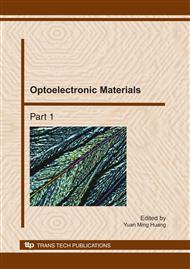p.1268
p.1273
p.1277
p.1281
p.1285
p.1289
p.1293
p.1298
p.1302
Effect of Heat Treatment Conditions on Microstructure and Infrared Transmission Property of Germanate Oxyfluoride Glass-Ceramics
Abstract:
Germanate oxyfluoride glass in CaF2/BaF2-AlF3-SiO2-GeO2 was prepared by melt quenching technique and subsequently converted to glass-ceramics with microstructures comprised nano-crystallites in a residual glass matrix by two-step heat treatments process. DSC, XRD, SEM and IR transmission investigations were used to determine structural characteristics and optical property of the prepared germanate oxyfluoride glass-ceramics. The influences of heat treatment conditions on crystallization behaviors and infrared transmission were discussed. The results show that crystal phase in the glass-ceramics is only Ge2Al6O13 and the crystal size is about 20nm-80nm when treated temperature ranges from 900 oC to 960oC. Good transparency is exhibited in visible light band to midinfrared band (5.0um) when treated temperature is low than 940 oC.
Info:
Periodical:
Pages:
1285-1288
Citation:
Online since:
November 2010
Authors:
Price:
Сopyright:
© 2011 Trans Tech Publications Ltd. All Rights Reserved
Share:
Citation:


